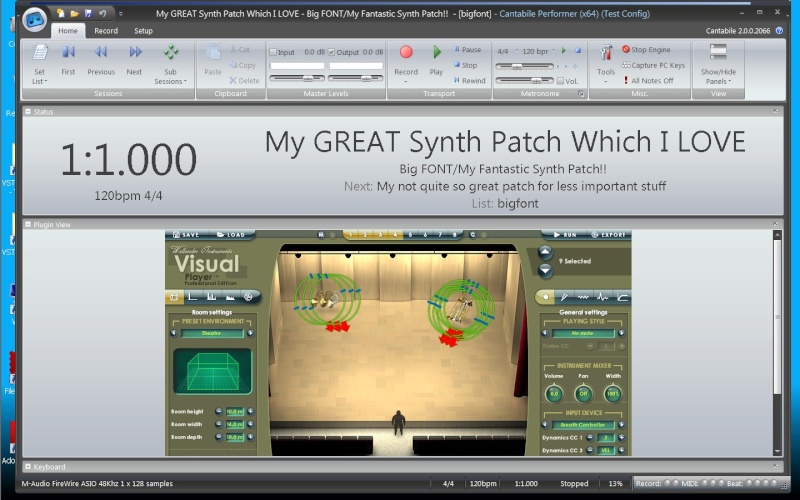- Is there any way to assign an effect to the final master bus before it goes to the stereo out on my sound card? I do notice that Cantabile has a built in limiter, which is great, but if I wanted to apply a single graphic EQ or gate or something to the entire mix...is there a way to do that?
- When does it make sense to put more than one VSTi into a single rack? seems like the program is ideally suited for using one instrument per rack and the only reason for putting more than one plugin in a rack is for serially processing the output, for example, to run a keyboard sound through amplitube or something like that. Do I have that right?
- When does it make sense to use the midi routing? Seems like the racks themselves do everything the midi routing does, so just by changing sessions or sub-sessions can essentially do the same things as using a midi route, unless I'm missing something? When is an applicable situation to use the midi router?
- Program changes are not clear to me yet. Sometimes I would need them to pass through to the plugin and sometimes I don't want the program c hange to go through, I want a certain preset selected and have plugin ignore program change. I dunno, what is the best practice here?
- I have 3 basic scenarios I would use cantabile and wondering what others thing would be the best way to set it up for easiest use.
One situation (A) is during a gig to move through a setlist. That is pretty obvious, I should use sessions and sub sessions, setup each subsession exactly the way I want, only move to new sessions as it makes sense for stuff that uses a lot of sample memory or something, but probably can have all the plugins I need for a set open in a session and just use sub sessions to mute and unmute them, change presets, keyboard splits, etc.
Another situation(B) is when rehearsing with my band where i need the flexibility of not having a setlist per say, but most of the time will need to setup complex splits for each song, etc.
Another situation(C) is when I just want my computer setup at home to play around, and from my master midi controller I would select which plugin I want to hear by changing midi channels. In other words it becomes a massive multitimbral instrument of sorts and I could either sequence it from another computer or just play one cantabile rack at a time by changing midi channels from the master and then using program changes on the midi controller to move through presets. What kind of session would I set up for that.
I'm also considering Mainstage2, as my PC is a bootcamp enabled MBP. Mainstage has some pros and cons also. In general its CPU use looks to be similar to Cantabile. However, its mixer view is more straightforward to understand then the Rack concept initially. It does not provide nearly the sophisticated midi routing as Cantabile. However one thing it does provide is a way to fully edit the gig-time scene view, including visual CC controls that can be mapped to VSTs, etc. That is very handy. I haven't been able to get that one to crash either. Its only $29 and comes with a bunch of other instruments too. However on the windows side there are a lot of great free plugins and I own a few windows only plugins like Cobalt and OPX, so maybe I will still end up on Windows for that reason alone.
I welcome all feedback but mainly on this forum I would like to hear best practices for setting up Cantabile for a typical gigging keyboardist. hahaha.. typical. Nothing is typical I guess..but just imagine..no track playback, no backing tracks, just use one or two midi controllers to play back keyboard sounds, sometimes layered, sometimes split, sometimes just one sound at a time...probably using only 2-3 plugins at any one time, but during a set needing maybe a dozen plugins available.



